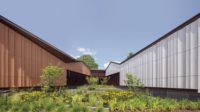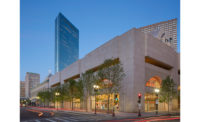Boston
In 2011, the Boston Public Library (BPL) decided to close two branch libraries in East Boston—home to the nation's first municpally supported branch library, built in 1870—and open a new one midway between the two. Amy E. Ryan, BPL president, posed a challenge to Boston-based architecture firm William Rawn Associates (WRA). “We got together and talked about what kind of design we could come up with that really serves the expectations of a population that doesn't speak much English, doesn't have experience with a public library, and maybe is even suspicious of government institutions,” says Ryan. “Libraries have never been as essential as they are today, for filling the achievement gap, bridging the digital divide, teaching English, helping people finding careers, enjoying literature.”
William Rawn and WRA principal Clifford Gayley's answer to Ryan's challenge was multifaceted, but it crystallized around a main idea: that the library should function as a single room where the entire community could come together. “It's this century's version of a great reading room,” says Gayley. “But instead of it being on a piano nobile, we placed it right near the front door, in a sense reaching out to the city.” The East Boston Branch library, which opened in November 2013, is a simple volume: a one-story rectangle with a rippling roof and ample glazing. It has a few virtuoso moves, which are all that are needed.
The first is that the architects oriented the library's main entry facade to face south, looking out on an 18-acre public park, giving patrons a view that culminates at the horizon in downtown Boston's skyline. To the east is a highway and, beyond that, Logan International Airport (hence the need for a lot of noise-canceling triple-glazing). To the west is a residential street. “We could have faced the library toward Bremen Street, but we said that the way this library is going to be memorable is for people to sit next to the window and enjoy the park,” says Rawn. “We started with that and then realized very early on that there was this view back to the city.”
To make the most of that view, the architects designed what they call a reading porch, an exterior extension of the library floor furnished with brightly colored Adirondack chairs and shaded by the deep roof overhang. Even on a freezing-cold day in January, the appeal of plopping in a chair with a book and a coffee during warmer months is obvious. “The civic nature of the site seemed fundamentally important,” muses Rawn. “It's a space that's all about opportunity. If you study hard in this library, you might be a lawyer in one of those buildings downtown—not that we all want to be lawyers.”
The challenge of creating a single-room library, though, is how to get daylight into the center of the building. In a few other Boston libraries, this problem was solved by creating an interior courtyard (as at BPL's central library in Copley Square, designed by McKim, Mead & White and built in 1895). The cost of an interior courtyard for East Boston was prohibitive, so Rawn and Gayley focused on the roof.
The architects began to play with alternately curving roof shapes. In order to create a column-free space, structural engineer Pete Cheever conceived two 60-foot-long lenticular trusses with no diagonal members, only verticals connecting upper and lower cords. The undulating structural components of the roof produce eye-like apertures that send daylight into the center of the library. “The ceiling and roof sandwich is as tight as possible,” says Gayley, which helps the roof look buoyant from the park and the highway. “The solution married our aspirations for the spatial experience while giving the roof enough verticality that it could stand up to a civic park.”
Inside, the swelling ceiling—hovering at 15- to 25-foot heights—is clad in hemlock slats. The warm wood sets the entire room aglow and hides sound-absorptive material behind it. This works well: when the library is busy with adults and children, the volume level stays at a pleasant murmur. Ryan and the architects dedicated a glassed-in reading room to patrons who still want a tomblike hush, pushing it to the western perimeter wall, behind the lobby desk. “Our common denominator is conversation,” says Ryan. “Why wouldn't you want this activity?”
That activity—tweens doing homework and playing computer games, adults reading books in armchairs set near the south-facing window wall (screened from glare by slender, horizontal hemlock louvers)—is encouraged by the room's subtle divisions into spaces for all ages through the use of furniture, rugs, and WRA-designed shelves on casters. The flexibility of all of these elements suggests which activities might be done where, but without hierarchy or rules.
Ryan says that the East Boston Branch library is twice as busy as the two locations that it replaced combined, and it's the second busiest of BPL's 25 locations. “We were trying to create a place where people want to be,” says Gayley. They succeeded.
People
Formal name of building:
Location:
Completion Date:
Gross square footage:
Total project cost:
Total construction cost:
Client/Owner:
Architect:
Personnel in architect's firm who should receive special credit:
Interior designer (FF&E, Finishes):
Engineers:
MEP/FP/IT/AV Engineer:
Geotechnical Engineer:
Civil Engineer:
Landscape:
Lighting:
Acoustical:
Other:
Code Consultant:
Geoenvironmental Consultant:
Commission Agent:
Sustainable Design Consultant:
Exterior Environmental Graphics:
Signage:
General contractor:
Photographer: Size: 15,000 square feet Construction Cost: $10 million Project Cost: $17.25 million
|
Products
Structural system
Exterior cladding
Roofing
Glazing
Doors
Hardware
Interior finishes
Lighting |












Post a comment to this article
Report Abusive Comment